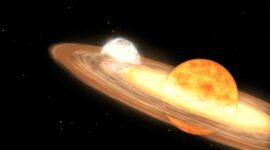October 25, 2025
The serene darkness of the pre-dawn sky, a canvas typically punctuated by the familiar, steady glow of distant suns, is now host to a visitor so extraordinary that it has sent shockwaves through the global scientific community and redefined the boundaries of astronomical possibility. Designated 3I/ATLAS, the third confirmed interstellar object ever detected within our solar system, is not merely a scientific curiosity; it is a profound anomaly, an event so statistically improbable and laden with potential that leading astrophysicists and planetary scientists have unanimously branded it a scientific “Black Swan” event. This term, popularized by scholar Nassim Nicholas Taleb to describe an event that is exceptionally rare, carries extreme impact, and is retrospectively rationalized as if it were predictable, fits 3I/ATLAS perfectly. Its detection on September 18, 2025, by the Asteroid Terrestrial-impact Last Alert System (ATLAS) in Hawaii, was just the beginning of a saga that has since escalated into one of the most intense and collaborative astronomical campaigns in history, one that now cautiously, and with rigorous skepticism, includes the search for potential signs of artificial origin.
The journey of 3I/ATLAS into human awareness began as a faint, fast-moving smudge of light. Dr. Eleanor Vance, a planetary astronomer at the University of Edinburgh and a key figure in the initial analysis, recalls the moment the data stream flagged the anomaly. “The orbital eccentricity was the first and most immediate red flag. It was off the charts, literally. We knew within hours of refining the trajectory that this was not a member of our solar system. It was a true interstellar vagabond, and its velocity indicated it had not originated from our own Oort Cloud. The sheer speed and hyperbolic path were undeniable.” This confirmation placed 3I/ATLAS in an exclusive club, following the detections of 1I/‘Oumuamua in 2017 and 2I/Borisov in 2019. However, it quickly became apparent that this new visitor was in a league of its own.
The “Black Swan” designation stems from a confluence of bizarre and unprecedented physical characteristics that distinguish 3I/ATLAS from any natural object previously observed. The first and most startling is its highly unusual shape and rotational properties. Early light-curve data suggested an extremely elongated, perhaps cigar-shaped object, similar to initial interpretations of ‘Oumuamua. However, as more powerful telescopes, including the Very Large Telescope (VLT) in Chile and the Keck Observatory in Hawaii, were trained upon it, a more complex picture emerged. The object exhibits a tumbling, non-principal axis rotation, but its light curve also shows brief, irregular periods of dimming that cannot be fully explained by rotation alone. This has led to speculation about a possible debris field or a highly irregular, non-solid structure surrounding a denser core.
Furthermore, and most provocatively, is the object’s apparent non-gravitational acceleration. As it journeys through our inner solar system, its path is deviating slightly from the trajectory predicted by gravity alone. While outgassing—the sublimation of ices into gas acting like a weak thruster—explained a similar phenomenon with ‘Oumuamua and is common for comets, 3I/ATLAS presents a puzzle. No conclusive coma, the fuzzy envelope of gas and dust typical of comets, has been detected around it. This absence of visible outgassing, coupled with a measurable change in velocity, is the central mystery that fuels both rigorous scientific inquiry and more speculative possibilities. Dr. Kenji Tanaka of the Japanese Aerospace Exploration Agency (JAXA) stated, “We are observing an acceleration without a visible engine. For a comet, the engine is the jets of gas we can see. Here, we see the thrust but not the plume. This forces us to consider a wider range of hypotheses, from the sublimation of very exotic ices to more complex structural explanations.”
It is this very void of a conventional explanation that has opened the door for a disciplined, scientifically-grounded search for potential artificial origins. A coalition of institutions, led by the Breakthrough Listen project and in coordination with radio astronomers from the Green Bank Telescope in West Virginia and the Allen Telescope Array in California, has begun a targeted campaign to analyze 3I/ATLAS for any signs of technology. The search is not for “alien messages” but for any form of non-natural radio or laser transmission, or even leakage radiation, that would indicate the object is not a simple rock or iceball. They are scanning a wide range of frequencies, particularly those that would be shielded from natural cosmic background noise. Dr. Anya Sharma, a project scientist with Breakthrough Listen, emphasized the cautious approach. *”It is the height of irresponsibility to jump to conclusions. Our mission is to apply the tools of rigorous observational science to an extraordinary object. We are looking for a needle in a cosmic haystack by systematically eliminating strands of hay. The null result—finding nothing artificial—is just as scientifically valuable as a detection. However, given the anomalies presented by 3I/ATLAS, to not look would be an abdication of our duty as scientists.”*
The possibility, however remote, has ignited a firestorm of public interest and ethical debate. The International Academy of Astronautics (IAA) has hastily convened a post-detection committee, a theoretical group that now must operate in reality, to draft protocols for how to handle and potentially announce any potential discovery of a non-human technology. The scientific consensus remains overwhelmingly in favor of a natural explanation, but the nature of that explanation is what has everyone so captivated. Hypotheses being debated in peer-reviewed pre-prints and urgent conference calls include the idea that 3I/ATLAS could be a ” fractal dust aggregate” or a “hydrogen iceberg”—exotic theoretical objects that could explain the acceleration without a visible coma. Others have suggested it could be a fragment from a catastrophic collision in a distant planetary system, a piece of a shredded exo-planet, possessing a composition and structure utterly alien to our own solar system’s debris.
The race against time is a critical element of this story. 3I/ATLAS is moving at a breathtaking 34 kilometers per second relative to the Sun. It made its closest approach to the Sun in late September and is now on its outbound journey, rapidly fading from view. Current estimates suggest it will be beyond the effective observation range of even the most powerful telescopes by mid-November 2025. This narrow window has triggered an unprecedented level of international cooperation. The James Webb Space Telescope (JWST) has diverted from its scheduled program to perform detailed spectroscopic analysis, seeking to determine the object’s composition by analyzing the sunlight reflected from its surface. Early, and still unconfirmed, spectroscopic data hints at a surface rich in complex carbon-based molecules and what appears to be an unusually high metal content, a finding that further deepens the enigma.
The implications of 3I/ATLAS extend far beyond the immediate astronomical puzzle. For the future of space exploration, it provides a tangible, urgent target. Concept studies for rapid-response interstellar probe missions, once relegated to science fiction and far-future technology roadmaps, are now being urgently re-evaluated by NASA and ESA. A mission to rendezvous with and sample such an object would provide a direct, physical analysis of material from another star system, a scientific prize of incalculable value. 3I/ATLAS serves as a stark reminder that our solar system is not an isolated island, but a dynamic port visited by celestial driftwood from the vast galactic ocean. As Dr. Vance summarizes, *”Whether 3I/ATLAS is a bizarrely shaped rock, a cosmic iceberg, or something else entirely, it is a messenger. It tells us that the galaxy is far more diverse, far stranger, and far more fertile with unexpected phenomena than we ever dared to imagine. It is a humbling and exhilarating reminder of how much we have yet to learn.”* As the world watches and the global astronomical community mobilizes its every resource, this rare “Black Swan” continues its silent, swift journey back into the interstellar dark, carrying its secrets with it and forever altering our perspective on our place in the cosmos. The final chapters of its brief encounter with humanity have yet to be written, but they are guaranteed to be studied for generations to come.




